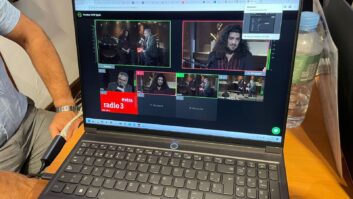GH One TV is Ghana’s fastest growing television channels, transmitting a wide range of current affairs, entertainment and lifestyle content. Since it started broadcasting three years ago, the station has carved a strong niche in the Ghanaian audience by capturing a unique viewership profile whose television preference rests mainly in those three specific genres.
Last year GH One rolled out support for Ultra HD following an upgrade of its studio facilities in Accra. “The customer was looking for a brand-new TV setup, provided on turnkey basis,” explains Marco Branzanti, video projects manager at Axel Technology. “The customer was looking also for a partner with the necessary know-how to assist him on a 360° regarding video and IT technology that included studio, cameras, lights, playout, technical interior, connectivity, networking and so on. Another important design driver was to have a partner that could have an international network and be also a system integrator.”
Founded 1996 in Bologna by Giuseppe Vaccari, who brought his 30-year experience in the international broadcast field, Axel Technology is an Italian Systems Integrator dedicated to manufacturing professional radio and television broadcast solutions. Currently, Axel Technology’s equipment can be seen in over 120 nations. In Ghana, the company works through its partner, Bahamus Limited.
In 2015 Axel and Bahamus won the opportunity to provide to GH One a complete radio system and a small MCR. “Thanks to the growing of GH One and the mutual satisfaction of the work, the customer decided to ask to Axel and Bahamus to be its partner and supplier for the further solution. The entire project has been designed from scratch by Axel Technology and Bahamus,” says Branzanti.

Challenging schedule
Branzanti continues: “This system was a real challenge with regards to timing. There was less than four months between the customer signature and the commissioning of the system. The customer gave final approval in late March 2016, and broadcasting began from the new studios on the 10 July, 2016.”
The provided solution was a complete system HD/4K, comprising a Master Control Room for two channels, two production control room, three studios – both real and virtual sets and a technical room. “Blackmagic products are the key ingredients in the system workflow – they integrate perfectly with Axel products,” states Branzanti. “In all PC servers, there are Decklink cards used for playouts, graphics, logging, etc. The HD/4K system also consists of Blackmagic switchers, routers, converters and multiviewers. This combination allowed Axel to get the best quality/price ratio.”
The equipment includes an HD MCR 40×40 Videohub routing switcher for connection with Production Control Rooms and incoming/outgoing signals. In addition, there is a 12×12 Cleanswitch Videohub with control panels for On-air switching, plus three Multiviewers.
“We opted for the CleanSwitch in the Master Control. It allows the switching of the main programme outputs through our playout software without switching glitches.”

Branzanti continues, “We also integrated two Axel Xplayout video servers with Decklink Duo2, two Axel DLGplus channel branding with Decklink Duo2, two Teranex for downscaling, Teranex mini for glue, one Smartscope, and one SmartView.”
The studios also include a mix of equipment including Axel Youplay productions servers, Decklink pros, Axel CGlive, Axel Youmix – for dekstop grabbing, IP decoding, and background generation, plus Hyperdeck and Smartscope. In addition, six editing suites have been equipped with Decklink Studio2
Setting standards
The 4k signal was built on 12G-SDI,” says Branzanti. “The customer requested to have a 4K studio, even if the final output is an SD/HD to satellite and DTT. The idea was to start with top quality, producing content at the highest standard which would stand out from the competitors that were already on that market.” Following the significant investment in the 12G-SDI studio, the broadcaster recently chose to expand its 4K capabilities further, by commissioning its first ever OB truck – again through systems integrator Axel Technology.
“Delivering the studio install and then the OB truck build represents one of the biggest broadcast projects ever undertaken in Ghana,” reveals Branzanti. “Because of the enormous variety of content that GH One produces, from live sports to news gathering, through to on-location interviews and shows, our single biggest challenge was designing an outside broadcast system that could adapt to cope with all of those requirements.”
The 14m long and 2.5m wide truck, built by Milan based ARET, can accommodate a production team of up to 20 people at any one time and has four distinct production areas. While the main production gallery can seat up to six audio and video technicians, as well as two directors, the truck also incorporates a post-production hub, studio spaces, including a green screen and virtual sets, as well as an independent television studio workflow.
“Fully expandable, the OB truck occupies a 15m by 4.80m footprint, allowing multiple productions to take place without staff feeling cramped. That means the vehicle can be used comfortably for longer periods,” explains Branzanti. “For example, the truck can have a fully-fledged television studio up and running for several days, rather than on a short-term, event orientated basis.”
Again, Blackmagic equipment much in evidence. For example, signal routing onboard is managed via a Smart Videohub 40×40. Housed in the OB’s technical control room, it sits alongside a rack of HyperDeck Studio Pro broadcast decks, used for both recording and backup purposes. Teranex Express standards converters are used, allowing production crews to up or downscale any incoming video sources from external contributors.
More than production
“As well as 4K production capabilities, a major part of the brief was to ensure that the truck would be able to incorporate footage and content coming into the OB from a host of external sources. When you’re on the road, you have to be able to contend with a whole range of formats and signals, and the Teranex converters give the engineers a very practical set of tools to convert everything into a consistent format for their broadcasts.”
Axel Technologies’ IT servers are also housed here, together with its playout and CG systems for titling, news tickers and graphics, which can all be added to the live programme mix. As with its studio facilities, the truck is also fitted out with 12G-SDI cabling, which allows single cable connectivity for Ultra HD signals. “This allows us not only to reduce the volume of cables within the truck, but also means there is less likelihood of signal degradation or dropout.”
The truck has a full range of ENG and remote control cameras, which can be rigged in the studio sets or used out in the field, for news gathering, sports production or covering live events happening across Ghana. Satellite and secure Wi-Fi connections are on board to allow the truck’s team to broadcast from wherever they are in the country, no matter how remote.

Redundancy played a huge part in the design of the OB truck’s workflow, and Branzanti explains how Blackmagic allowed the Axel team to develop a bespoke solution. “The truck has two ATEM 2 M/E Broadcast Studio 4K switchers connected via a patch panel, and both have the same IP address assigned so that if there were any disruption, the console would automatically connect to the backup unit. The price point of Blackmagic’s switchers is what made this approach possible. We couldn’t have done it otherwise.”
A further ATEM 1 M/E Production Studio 4K is also installed for the truck’s television studio and is configured to act as the master control for the system. “The ATEM switcher’s ability to manage embedded audio makes it a very affordable and practical solution for any OB build which needs to be able to handle broadcast grade productions without any studio support.”
He adds, “The balance between affordability and functionality that the Blackmagic Design kit has been the key to the effectiveness of the GH One truck. We’ve been able to implement 12G Ultra HD workflows that have not previously been seen before in Ghana, that give the GH One team state of the art broadcasting systems, both when working in the studio and out in the field.”







